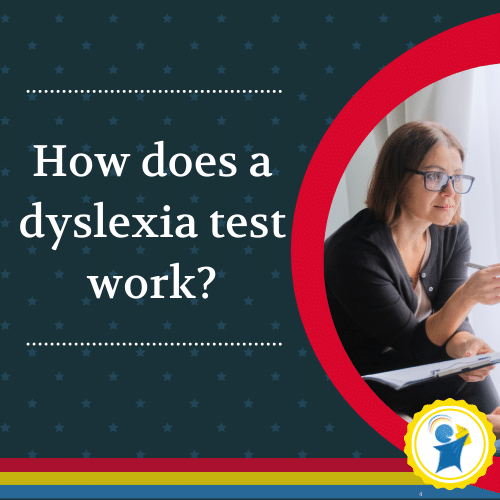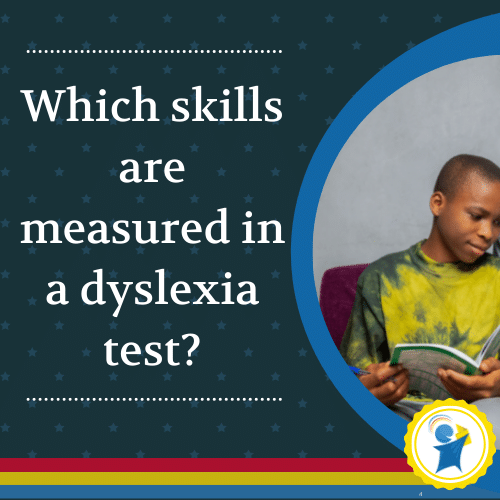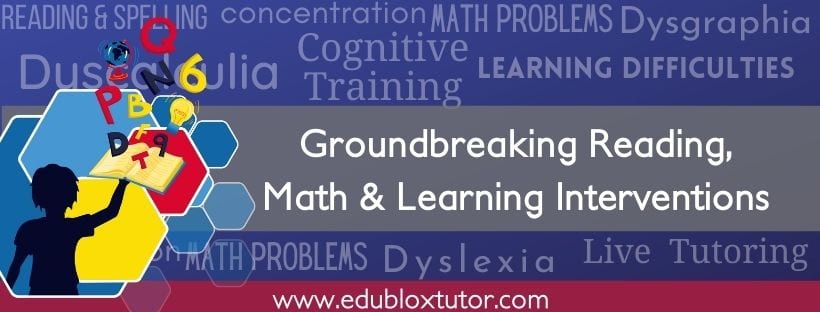Table of contents:
How does a dyslexia test work?

If your child has undergone a screening and there are signs of a reading difficulty, the next step is usually a complete educational assessment. These are known as educational or psychoeducational assessments/evaluations. Before you book one, knowing what is likely to happen before, during, and after the evaluation is important.
Does my child need a dyslexia test?
These evaluations can be expensive and time-consuming, so you should consult with all the relevant stakeholders in your child’s education before you pursue one. This includes educators or therapists who play a role in your child’s life.
The recommendation to seek an assessment often comes from the child’s primary teacher. Most school districts have rules governing the procedure for dyslexia assessment. These rules cover the process from identifying problems to implementing measures to accommodate and support students who receive diagnoses. These rules vary from state to state, so you should check with your local school district. Generally, though, the steps go in this order:
- The teacher advises the school about a child’s learning difficulties (as yet undiagnosed) through results, observations, and general impressions;
- The school advises the parent of the need for screening and/or testing;
- Permission is granted to assess (if this is done internally);
- Assessment.
As a parent, you have certain rights and responsibilities regarding your child’s educational journey. In particular, you are entitled to an Individualized Educational Plan (IEP) if an assessment shows your child needs this kind of support.
How to prepare for dyslexia testing
A full assessment involves a large number of different tests. These tests address various skills and competencies. They are not only time-intensive but can also be very taxing for your child. Practitioners should minimize this by ordering and structuring the tasks coherently. To add complexity, a child undergoing assessment may know what is happening. Anxiety can arise as a result. Once you have an appointment, here are some practical tips:
- Put your child’s mind at ease: Many children have heard of dyslexia, dyslexia testing, and learning difficulties. Approaching an assessment can evoke stress, feelings of inadequacy, or a sense that something is wrong. This may impede your child’s performance on the tasks, so you must help your child feel comfortable. It would be best to inform the assessor of any significant anxiety.
- Provide all the information the assessor requests: Assessors often ask parents to complete questionnaires or submit documents relating to a child’s medical, educational, and psychological history. Ensure that you supply all of this timeously and in detail. You want the final report to be as thorough and informative as possible in order to get services for your child. You can help the process by being organized and efficient.
- Ensure your child has had adequate food and rest: A tired or hungry child will not be able to complete tasks. This matters because you want the assessment to give a truthful indication of your child’s abilities. Your child should be cooperative and relaxed throughout the session.
What to expect on the day of the assessment
Usually, the assessment proceeds between the assessor and the child alone. However, depending on a child’s needs and history, the assessor may permit parents to be present. The practitioner will always use a comfortable room with few distractions. The assessor will take the child through a battery of tests and assessments over the course of a few hours. The tests chosen may be influenced by the nature of the referral. The practitioner will select appropriate instruments if the teacher or parent has specified the nature of the problems observed.
Which skills are measured in a dyslexia test?

An assessment does not measure one skill in isolation. Because of the nature of a specific learning disability, many different skills can be relevant to a diagnosis. There may be a deficit in visual, auditory, or memory skills. A particular child’s deficit may exist in one, two, or more academic areas.
To this end, a full educational assessment incorporates a range of tests of different skills and abilities. Practitioners use these in order to measure a child’s competence in relevant areas such as:
- Phonological awareness
- Decoding
- Fluency
- Comprehension
- Rapid naming
.
Below, we will look at these important skills.
Why is phonological awareness measured?
In an assessment report, terms like phonological awareness and phonological processing usually feature prominently. This is because reading relies on the acquisition of language, including sounds. If you have normal phonological awareness, you can recognize and discriminate between the sounds in your own language. For example, you can tell when two words rhyme. You can break words down into syllables or identify groups of words according to some criterion: “Which words begin with ‘m’?”
What is decoding and why is it measured?
To be a good reader, you have to be able to decode words. You do this when you see words in a text and successfully identify them. To do this correctly, you need to be able to connect sounds with symbols. Particularly if it’s a new word, you may need to blend individual segments together.
Decoding skills need to be in place for proficient reading to develop, but that is not enough. There are words that you cannot decode. For example, words whose spelling is very different from their sound, such as “enough.” To successfully read English, you need to recognize this word as you would recognize someone’s face. Words that have a high frequency (occur often) or must be learned by sight are called sight words. Typically, tests that clinicians use to assess decoding will address both domains: decodable words and sight words.
Reading fluency: What is it and how is it measured?
Another important aspect of proficient reading is fluency. In the literature on reading and cognition, fluency is treated as a synthesis of three related factors. A comprehensive dyslexia test will typically consider all three of these in order to evaluate a child’s reading fluency.
- Speed/Pace: Good reading must be fairly quick. If you read too slowly, the short-term memory cannot hold onto the information from the beginning of a passage to the end. This is a problem because you need to access all of the information to draw the conclusion the writer wants you to draw. The most common unit of measurement for reading pace is words per minute.
- Accuracy: Inaccurate reading is useless, at best. If you are a proficient reader, you have a large repertoire of words you can treat as sight words. These are words that you recognize without the need to decode them. At an even higher level, you can take in entire chunks of language at a time.
- Prosody: The third factor that undergirds fluency in reading is prosody. This term refers to things such as rhythm, pitch, and tone. For example, when you ask a question, you may raise your voice slightly as you approach the end. To read effectively, you need to be able to “hear” the text and apply the corresponding features, even when you read silently.
How do we measure comprehension?
Reading comprehension refers to a reader’s ability to interpret a text successfully. Of course, it’s not enough to simply read a passage accurately. To be a proficient reader, you must understand what you read, which can only happen if you are able to decode the words and sentences. Another condition necessary for comprehension is fluency. This makes intuitive sense. After all, it isn’t easy to understand someone who speaks haltingly or without natural intonation.
Dyslexia tests that target reading comprehension are usually interested in either literal comprehension, inferential comprehension, or both. Literal comprehension is a reader’s understanding of the events and information in a text. To test it, you can ask a child questions like “What happened?” or “Where did it happen?” Answers to these questions are all available in the text itself.
Inferential comprehension depends on literal comprehension but goes further. The reader can form judgments that make sense (inferences) about the text, the author, or aspects of the text. For example, questions about the moral of a story and the writer’s intentions rely on inferential comprehension. In order to deal with a text at this level, the literal level has to be automatic and effortless.
Teachers and psychologists in the United States commonly use a wide range of tests to assess comprehension skills.
What is rapid naming? Why does it matter for a dyslexia test?
Rapid naming happens when you recognize something instantly and effortlessly and say what it is. This can happen with anything – objects, symbols, and colors at the most basic level. At a higher level, this can include words and phrases. Rapid naming must happen effortlessly and quickly for effective learning to occur, which is why it’s also known as Rapid Automatic Naming (RAN).
Dyslexic readers frequently show weaknesses on tests of rapid naming ability. There is ongoing debate about whether the underlying deficit is visual or phonological in nature. In any event, the strong correlation between dyslexia and difficulties with rapid naming justifies its inclusion in dyslexia tests.
After dyslexia testing
Once the assessor has completed the tests, you will have a feedback session to discuss the results. This point in the assessment is crucial. You should ask for clarification of anything you do not understand. You should also not be intimidated by the use of jargon or dense vocabulary; most of the concepts can be expressed straightforwardly.
The structure of a report
Once the assessment is over, you will have the report. You should think of this document as a tool. You can use it as a way of opening opportunities for your child. The structure of a report will vary from one practitioner to the next, but it should contain the following elements:
- The reason for referral: The clinician should outline the reasons for the assessment. This will draw on any reports that the teacher or parent submitted. This section may also contain an overview of the child’s history, with relevant observations from other professionals who have had a stake in their education.
- Clinical observations: This section is usually written in full prose, not checklists or tables. A good assessor will describe the impression a child made throughout an assessment. These observations are salient for you and any other party with a say in your child’s education. An assessor might note things that tests do not capture but will be important in decision-making, such as social and emotional responsiveness or practical things like pencil grip. Information like this can help to make any subsequent treatment plan more effective.
- List of tests used: There is a bewildering array of tests measuring different skills. For any given aspect of learning, a clinician will often have dozens of well-established tests to choose from. Ideally, practitioners should be able to explain and justify their choices to clients. If you are uncertain about any of this, ask. The relevant information may feature in the body of the report or as an appendix.
- Results and interpretation: The report should provide the child’s score on each test and an interpretation of that result. The interpretation usually unpacks what the result means, and compares the score to the standard score or the one expected for a child of comparable age.
Interpreting the report
Testing for dyslexia involves assessing a wide range of skills. Measuring these requires a variety of educational, psychometric, and psychological tests. This is why an assessor needs to be conversant with technical terms and broader developments in the field.
These are common terms you may encounter in an assessment report.
- Standard score: This is a score that rates a particular child against the peer group. Tests that are regarded as comprehensive and trustworthy by practitioners have standard scores based on a large number of samples. With many tests, the standard score is supplied next to your child’s. The difference between these two numbers (if any) is important, especially if it is significant.
- Percentile: Many scales categorize scores in percentiles. Similar to a standard score, this gives us a way to understand how a child is doing compared to children of similar age. If you are in the 50th percentile, your score was equal to or higher than 50 percent of the people in the group. The higher the percentile, the better.
- Diagnosis: If relevant, the assessor will diagnose your child with a specific learning disability. Because most psychoeducational assessments involve a broad range of data, more than one diagnosis can emerge. For example, the assessor might determine that a specific learning disability like dyslexia exists alongside an emotional or psychological disorder. There may also be no diagnosis but only recommendations.
- Recommendations and resources: The practitioner should recommend a course of action to deal with problems that arose during the dyslexia test. In addition, a report may include appendices with tools and strategies that a parent can begin to implement at home prior to any official or institutional intervention.
Receiving the results of a dyslexia assessment represents the end of one process and the beginning of another. You now have a tool that clarifies the problems in your child’s life. You also have a basis for acquiring accommodations or services so your child can, hopefully, thrive in school.
Edublox offers live online tutoring to students with dyslexia. Our students are in the United States, Canada, Australia, and elsewhere. Book a free consultation to discuss your child’s learning needs.
Authored by Susan du Plessis (B.A. Hons Psychology; B.D.), an educational specialist with 30+ years’ experience in the field of learning disabilities, and Dylan Arslanian (B.A. Hons Linguistics, Cambridge DELTA).

